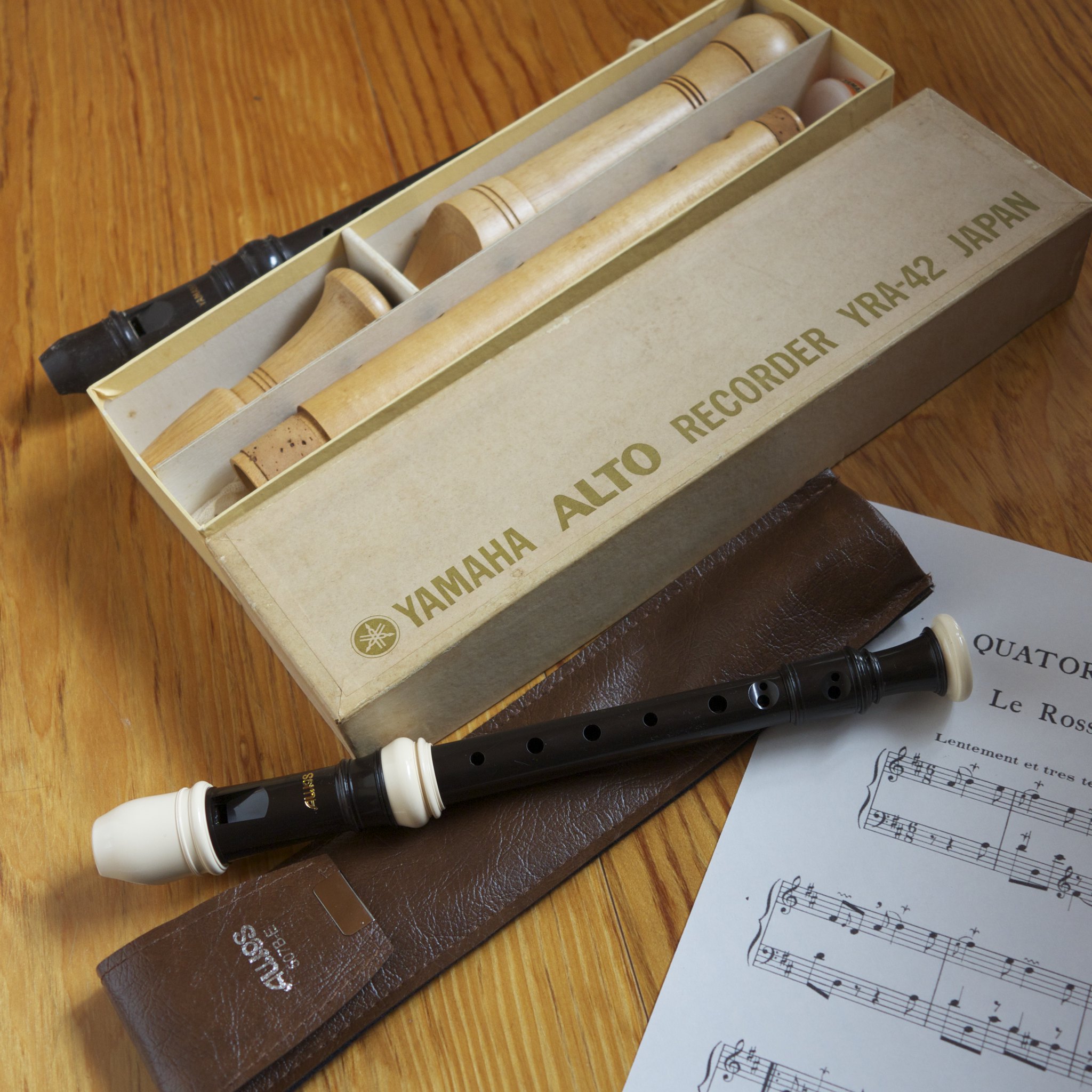The flute family: a collection of flutes of various sizes and ranges that produce a wide range of possibilities for the flutist. There are several members of the flute family. Today we will go over some of the more widely known members, but I'll be sure to add a few (if not all) oddities!
The Concert Flute (In C)
Typical Range: C4 to C7 (See Also: Flute Range) Transposition: This is a non-transposing instrument. The pitches it reads on the page are the pitches that are sounded.
The Concert Flute, or simply the flute, is the primary member of the flute family. We have covered the history of the development of this flute extensively in our article on The Wooden Flute. In fact, the history of the flute family is tied very much into the various construction methods and innovations over time.
Prior to the technical innovations that allowed the flute to play chromatically, flutes were constructed in all different keys so that they could play with all different instruments and on different types of music.
Today, the flute is the first instrument in the family that most flute students learn to play, and any flutists being hired into an orchestra or other ensemble is expected to have a great facility on this instrument.
There is a variety of repertoire for the instrument from solo works to orchestral concertos, but the instrument can also be heard in marching bands, concert bands, jazz, and much more.
There are so many iconic pieces for this instrument, but Prélude à l'après-midi d’un faune (‘Prelude to the Afternoon of a Faun’) by Debussy, is definitley a highlight in my book.
The Piccolo (In C)
Typical Range: D5 to C8 Transposition: The pitches it reads on the page are sounded one octave higher.
The piccolo, playing an octave higher than the flute, is perhaps the second-most well-known member of the flute family. Due to the acoustics of the flute, the piccolo, with a tone that can carry a further distance, is usually the preferred flute family member in marching bands.
In orchestral literature, Beethoven's Symphony No. 5 in C Minor is often hailed as the first appearance of the instrument, but lesser-known composers from Mozart's time, such as Franz Anton Hoffmeister and Michael Haydn were known to use the instrument in their works.
As flutist began to explore the unexplored, repertoire for solo piccolo began to emerge, and now there is a wide range of music composed for the instrument, elevating it to a status beyond an added color for large ensembles, and giving it its own place.
Perhaps the most widely known instance of the piccolo, at least to American audiences, is John Phillip Sousa's "Stars and Stripes Forever," which features a very exposed piccolo solo, which has become iconic for the instrument.
Alto Flute (In G)
Typical Range: G3 to G6 Transposition: The pitches it reads on the page are sounded a perfect fourth lower.
The alto flute is the only main member of the flute family not in the key of C. It is a beautiful instrument with a very warm sound, and perfect for chamber music settings.
In order to get the lower pitch, the instrument is made larger and longer, and as such, some alto flutes have curved head joints to make it easier for the performer to reach the keys.
The alto flute is found in orchestral music, but sparingly, as it is used mainly for color. It can be found in works by Stravinsky and Ravel. If you are familiar with Holst's The Planets, the flute choir sound at the opening of Neptune is an Alto Flute and Two Concert Flutes, joined shortly after by a piccolo.
While a modern orchestra will hire a dedicated piccolo player, it is assumed that any repertoire needing the alto flute would be hired on-demand or would be filled by one of the existing flutists in the orchestra.
There are some beautiful solo works for the instrument, most of which have been composed within the last fifty years as flutists started exploring the entire range of the flute family.
While not an original work for alto flute, this arrangement of Rachmaninoff's Vocalise for Alto Flute demonstrates the tone and character of this instrument.
Bass Flute
Typical Range: C3 to C5 Transposition: The pitches it reads on the page are sounded one octave lower.
The Bass Flute is perhaps the last of the "well known" members of the flute family. It is pitched in C and sounds an octave lower than your typical concert flute.
It is always played with curved headjoint, and it is the lowest flute in the family that is played without the instrument being propped on the ground (yes, they get bigger).
The bass flute is more about extending the range for flute players than it is about filling an orchestral need. In fact, there are very few bass flute parts in orchestral literature, but as the instrument becomes more widely in chamber music circles, compositions will begin including it more and more. The bass flute is used a lot in eastern and eastern-sounding works, as it is a western flutist's way of being able to access the range and tone color we are used to hearing from eastern wind instruments.
Hopefully, you will pardon another example, because one of my all-time favorite pieces for flute is Bolling's Suite for Flute and Jazz Piano Trio. It was written by Claude Bolling for legendary flutist Jean-Pierre Rampal. The opening of the sixth movement is played on the bass flute and is a very iconic piece in the repertoire. And with the magic of YouTube, we have access to a video Rampal and Bolling playing this piece.
Contrabass Flute
Typical Range: C2 to C4 Transposition: The pitches it reads on the page are sounded two octaves lower.
We have already covered the contrabass flute extensively, and I encourage you to check it out if you want a more detailed overview of the instrument.
As of writing this article, there are no known instances of the contrabass flute being used in standard concert bands or orchestras. It is a solo and chamber music instrument, with a small group of low flute specialists championing and commissioning music for this instrument. It is becoming more and more common in flute choirs, and a lot of those ensembles are ensuring they have a couple of these instruments on hand to cover that repertoire.
Here is a bit of improvisation on the instrument, which showcases some of its capabilities.
The Promised Oddities
The flute family is vast, and there are a lot of other instruments that are a member, though not often seen.
The Treble Flute (In G)
Typical Range: G4 to G7 Transposition: The pitches it reads on the page are sounded a fifth higher.
This instrument sits between the flute and the piccolo and comes from a long development of flutes being pitched in different keys.
There are actually a couple of instances of this instrument being written for, such as in the 19th-century opera Ivanhoe.
Irish flutists who want a Boehm system flute instead of the simple system instruments usually found in traditional Irish music can sometimes be found with these treble flutes.
These are still made today, but typically made on-demand and are rather rare. You may find one in a flute ensemble, but I wouldn't look to hard.
Here is a bit of the treble flute in G (if you watch from the start of the video, you'll also see the soprano flute in Eb).
The Soprano Flute (in E-flat?????)
Typical Range: Eb4 to Eb7 Transposition: The pitches it reads on the page are sounded a minor third higher.
This instrument is pretty much non-existent. It was prominent at a time when a flutist might need to double or cover a party written for an Eb Clarinet.
But this guy has one, and he jams.
The Flute D'Amour (in A-flat, A, or B-flat)
Typical Range: Ab/A/Bb3 to Ab/A/Bb6 Transposition: The pitches it reads on the page are sounded a major third/minor third/major second lower.
This step between an alto flute and a concert flute is also pretty much non-existent in modern times. However, it does have a small repertoire written for it by the likes of Bach and Holzbauer.
Even Verdi's opera Aida has a scene in the finale of act one that has a dance played on a trio of flute d'amour but those parts are often reassigned in modern performances.
Here is a Flute D'Amour in A
Contra-alto (aka Bass Flute in G)
Typical Range: G2 to G5 Transposition: The pitches it reads on the page are sounded an octave plus a perfect fourth lower.
The Contra-alto sits a fourth lower than the bass flute, so don't let the name get to you.
It is the first of the flutes to be designed to sit on the floor.
Ok, this is getting ridiculous...
Yes, yes it is... and we love it...
Subcontrabass Flute (In G)
Typical Range: G1 to G4 Transposition: The pitches it reads on the page are sounded two octaves plus a perfect fourth lower.
Here is a sub contrabass flute played by Peter Sheridan, one of the influencers in the low flute world.
Double Contrabass Flute (In C)
Typical Range: C1 to C3 Transposition: The pitches it reads on the page are sounded three octaves lower.
Despite this miss-titled video, this is a contemporary performance of the double contrabass flute.
Hyperbass Flute (In C)
Typical Range: C0 to C2 Transposition: The pitches it reads on the page are sounded four octaves lower.
If there is anything that is a "novelty," the recent invention of the hyperbass flute is just that. Its lowest note is considered beyond the range of normal human hearing.
This instrument is new. The first fully chromatic hyperbass flute was made in August 2010. There are only a couple in existence.
As a sample of what this instrument sounds and looks like, here is a photo montage of the construction of a hyperbass flute accompanied by a performance of the instrument.
The Flute Family
The flute family is vast, and flutists want to explore more and more every day the extreme ranges of their craft. From extending the range as low as possible to finding old oddities and flutes in unusual keys, flutists will continue to explore the depths of their craft within the flute family.




